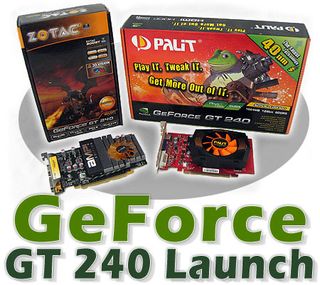GeForce GT 240: Low Power, High Performance, Sub-$100

Introduction

Let's face it. The situation has been less than ideal for Nvidia over the past few months.
The first thing that comes to mind was the successful launch of AMD's new DirectX 11-ready Radeon HD 5000-series. Nvidia doesn't yet have its DirectX 11 answer ready. Admittedly, though, with scant availability of AMD's high-end Radeon HD 5870 and 5850 cards, this isn't the root of Nvidia's problems. The real thorn in the company's side is the fact that AMD has proven twice now, without a doubt, the smaller, scalable GPU and GDDR5 route it took with the Radeon HD 4000- and 5000-series is a winner from a price/performance/profitability standpoint.
As a result of AMD's success selling low-cost graphic cards with modest 3D performance, Nvidia has been forced to squeeze high-end GPUs into service as sub-$100 trench fighters. Take, for example, the GeForce 9600 GSO, 9600 GT, and 9800 GT, none of which were ever originally intended for the sub-$100 market. Complex GPUs and memory buses keep costs high, power usage is usually abysmal compared to the efficient Radeon HD 4670, and performance can't quite approach the Radeon HD 4850. The newer G96 version of the GeForce 9600 GSO helped cut costs a bit with its narrower 128-bit memory interface, but the majority of sub-$100 GeForces likely remain more expensive to manufacture than their Radeon counterparts.
With Nvidia's next-generation DirectX 11 flagship 'Fermi' delayed until next year, its prospects for wowing video card buyers in the near future are looking pretty dim. We had hopes that the recently-released GeForce G 210 and GT 220 would shake things up a little. And while the combination of 40nm lithography and DirectX 10.1 support helps the GeForce GT 220 bring a fight to ATI's Radeon HD 4650, the Radeon HD 4670 remains unchallenged when it comes to price/performance and low power usage.
Unchallenged, that is, until today.
The company is now officially unveiling its GeForce GT 240, the most powerful reference card that doesn't require an auxiliary PCIe power connector. It doesn't have DirectX 11 support, but it has exactly what Nvidia needs right now in the sub-$100 category: low production costs, low power usage, and better-than-Radeon HD 4670 performance. Should it matter that ATI has a pair of entry-level DirectX 11 GPUs planned for Q1 of next year? Only if you're willing to wait. Let's see what Nvidia is offering today.
Stay On the Cutting Edge: Get the Tom's Hardware Newsletter
Join the experts who read Tom's Hardware for the inside track on enthusiast PC tech news — and have for over 25 years. We'll send breaking news and in-depth reviews of CPUs, GPUs, AI, maker hardware and more straight to your inbox.
Current page: Introduction
Next Page GeForce GT 240 Specifications And Hardware-
rodney_ws Well, it appears I might be the first poster... and that's pretty indicative of how exciting this card truly is. At any price point it's just hard to get excited when a company is just re-badging/re-naming older cards. DDR5? Oh yay! Now about that 128 bit bus...Reply -
Ramar I really can't justify this card when a Sparkle 9800GT is on newegg for the same price or less than these cards. Perhaps if energy costs are really important to you?Reply -
Uncle Meat ReplyBefore we get into the game results, something we want to stress is that all of the GeForce cards we used for benchmarking ended up being factory overclocked models, but that our Diamond Radeon HD 4670 sample is clocked at reference speeds.
The memory on the Diamond Radeon HD 4670 is clocked 200Mhz below reference speeds. -
rodney_ws Also, the 9600 GSO was on the Egg for $35 after MIR a few weeks/months back. No, that's not a top-tier card, but at $35 that's practically an impulse buy.Reply -
http://store.steampowered.com/hwsurvey/videocard/Reply
Looking at what cards people actually have (8800gt mostly), I think there are very few that would want to upgrade to this. Give us something better, Nvidia! The only reason why Ati doesn't have a 90% market share right now is that they can't make 5800s and 5700s fast enough. -
jonpaul37 the card is pointless, it's Nvidia's attempt to get some $$$ before an EP!C FA!L launch of FermiReply -
jonpaul37 The card is pointless, it's Nvidia's attempt to get some $$$ before an EP!C FA!L launch of Fermi.Reply -
JofaMang No SLI means they want to force higher profit purchases from those looking for cheap multi-card setups. That's dirty. I wonder how two 4670s compare to one of these for the damn near the same price?Reply -
KT_WASP I too noticed the discrepancy in your stated numbers for the Diamond 4670. In the article it states 750MHz / 800MHz (1600 effective). But then in your chart it states 750MHz / 1000MHz (2000 effective).Reply
So, which one was used? Reference is 750/1000 (2000 eff.) Diamond had two versions, I believe, one at the reference speed and one at 750/900 (1800 eff.)
Just trying to understand you pick so we could better understand the results.
Most Popular



